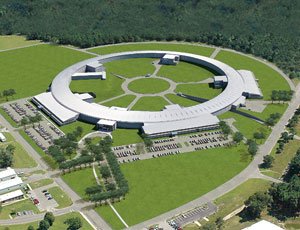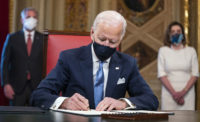Engineers, contractors and owners are boarding the Energy Dept.’s $32.7- billion gravy train, augmented by $12.5 billion in loan programs, as it leaves Washington, D.C.
Energy Secretary Steven Chu’s last job was as director of Lawrence Berkeley National Laboratory. His familiarity with the condition of lab facilities may be why DOE is pouncing on the $1.6 billion in funds appropriated by ARRA, with half earmarked for construction, infrastructure, equipment acquisition and research at nine national laboratories in seven states (see table below). The largest share for a single project is $150 million to accelerate construction on the National Synchrotron Light Source II project at Brookhaven National Laboratory, Upton, N.Y.

In February, Torcon Inc., Red Bank, N.J., was named general contractor with a $170-million contract to build the 240,000-sq-ft ring building and nearly 100,000 sq ft of support buildings. Four more prime contracts totaling $41 million will be awarded by February 2010. HDR Inc., Omaha, is the architect-engineer for the project, whose total cost is $912 million. Torcon received notice to proceed on March 25, with commissioning scheduled in 2015.
Construction is under way at Thomas Jefferson National Accelerator Facility, Newport News, Va. The lab received $75 million from ARRA, of which $65 million will be applied to the facility’s 12-GeV Upgrade, a $310-million construction project. The construction value is $28 million on the design by Hayes, Seay, Mattern & Mattern Inc., Roanoke, Va. In February, S.B. Ballard Construction Co., Virginia Beach, Va., was named the contractor for the building shell, with a contract value of $14.1 million. Construction completion is scheduled in 2011, with commissioning in 2015.
Breathing Room
Two federal power agencies, the Bonneville Power Administration (BPA), Portland, Ore., and the Western Area Power Administration (WAPA), Lakewood, Colo., are sharing equally $6.5 billion in borrowing authority under the recovery act. The authority to borrow $3.25 billion from the U.S. Treasury will give “a lot of breathing room” to BPA spokesman Doug Johnson.
BPA has a sizable roster of transmission construction projects in various stages and has been proceeding on them with $4.45 billion in prior borrowing authority. “Getting that [additional] funding gave us the confidence that we would have adequate capital,” says Johnson. The agency now is soliciting bids for the 79-mile-long, 500-kV McNary-John Day line, estimated at $246 million, and expects to name a contractor in June.
“We’re looking at a very significant increase [in capital expenditures] over the next few years,” says Johnson. Before the new borrowing authority was granted, BPA would have run through its available funds by 2013. “This extends that date well into the future,” he says.
Unlike BPA, WAPA never had authority to borrow from the Treasury for capital expenditures, says LaVerne Kyriss, senior planning advisor. With the new funding, WAPA is conducting two public processes for transmission projects to support renewable energy. One is to solicit interest in identifying potential transmission projects to build; the other to solicit participants to partner with WAPA to build them. Responses were due on April 3. The winners will be announced in the Federal Register this summer.
Engineers and contractors expect to see business opportunities from recovery act funds, but most say it’s too soon to talk about specific opportunities. Better definition should become clear in two or three months, but it will be closer to year’s end before ground rules and processes are in place, says Richard Rudden, senior vice president of Black & Veatch’s Enterprise Management Solutions division, Happauge, N.Y. “It’s not just a paper matter; it’s a people matter too,” he adds.
DOE’s inspector general has reported the department may not have enough contract specialists to handle the programs it plans to implement under the recovery act.
Pacific Gas & Electric Co., San Francisco, has not decided whether to seek funding under ARRA because the rules are not yet published, says Kevin Dasso, PG&E’s senior director of asset strategy and planning. “All the utilities are in the same boat. Utilities are developing potential candidates” for funding, he says.
| Laboratory | Amount ($mil.) | Purpose |
|---|---|---|
|
Ames Laboratory, Ames, Iowa | 1.7 | Modernization to improve energy consumption |
|
Argonne National Laboratory, Argonne, Ill. | 13.1 | Preparations for central campus rehabilitation |
|
Brookhaven National Laboratory, Upton, N.Y. | 184.3 | Construction of National Synchrotron Light Source II |
|
Fermi National Accelerator Laboratory, Batavia, Ill. | 34.9 | Construction of 15-kiloton neutrino detector and infrastructure projects |
|
Lawrence Berkeley National Laboratory, Berkeley, Calif. | 115.8 | Construction of Advanced Light Source User Support Building, decommissioning, seismic improvements |
|
Oak Ridge National Laboratory, Oak Ridge, Tenn. | 71.2 | Laboratory modernization, construction, repairs and improvements |
|
Pacific Northwest National Laboratory, Richland, Wash. | 124.0 | Laboratory equipment and energy conservation projects |
|
SLAC National Accelerator Laboratory, Menlo Park, Calif. | 68.3 | Equipment acquisition and modernization; seismic upgrade for buildings |
|
Thomas Jefferson National Accelerator Facility, Newport News, Va. | 75.0 | 12 Giga Electron Volt Upgrade; laboratory infrastructure improvements |
| SOURCE: DEPT. OF ENERGY | ||
The smart grid is one area where ARRA funding could help, says Dasso. The smart grid is “a journey, not a set of products,” he says, and the funds can help by accelerating development of technologies such as communication, data management, sensors and controls.
“On balance, [the market] is probably going to be pretty good for us,” says Black & Veatch’s Rudden. “There’s a lot of spending coming in areas of critical need for future investment,” such as transmission, smart grid, alternative energy and carbon capture and storage, he says.
Hand sees opportunities in renewable energy, and not just because the recovery act extends the tax credits. “Obama speaking so favorably about this topic is definitely driving down the fear to invest,” he says. Renewable-energy developers who are unable to get bank financing will tap the $6-billion DOE loan guarantee program under ARRA. Such developers “are very interested in those loan guarantees,” says Dasso. “We’ve heard that from independent-power producers.”
ARRA funds will create opportunities for mechanical/electrical/plumbing contractors across several markets, says Lonnie Coleman, president of the Mechanical Contractors Association of America, Rockville, Md. The General Services Administration, for example, has received $4.5 billion to make GSA facilities “high-performance green buildings” as defined by the Energy Independence and Security Act of 2007.
Almost $9 billion is available to states for discretionary spending on public safety, schools and higher-education-facility modernization, repair and modernization, says Coleman. “These measures are good for the economy, but only when the money is obligated to specific projects and contracts, and when contractors—like our members—use it to employ people and buy materials and equipment,” he says.




Post a comment to this article
Report Abusive Comment